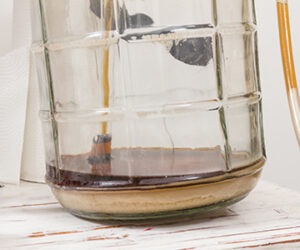Dry Hop Like A Pro
Dry-hopping beer is a centuries old practice that lends hop character to beer. It’s simply adding hops to either beer or wort (the pre-fermentation liquid) but after the boil and chill phases of the beer’s life. Some brewers will add their dry hops as early as they add the yeast. Others may wait for over a year when barrel-aging a beer. The goal is simple: Give the beer extra hop character . . . but the road to get you there can fill books. So let’s start by covering some of the basics.

Is Sanitation Needed?
I wanted to start with allaying fears. This is a common question we receive at BYO: Do I need to sanitize my dry hops? While just about everything brewers place into fermenters should be either pasteurized or put through some form of sanitation step; hops are not included on this list. Hops can be added directly to your fermenter without fear of infections. There are cases where infections do seem to arise after dry hopping, but most times the root cause is from a phenomenon known as hop creep and not from a wild bacteria/yeast riding on the coattails of the hops (for more on hop creep, see the January-February 2019 issue’s “Mr. Wizard”: https://byo.com/mr-wizard/hop-creep-explained/). Neither spoilage bacteria nor wild yeast that are found living on hop cones thrive in beer. However any bags or containers that hops are added to for dry hopping should be thoroughly cleaned and sanitized though.
When to Add
The general idea is that you’ll want to have your dry hops added just a few days to a few weeks prior to packaging. For those that keg their beers, they can even add the hops directly to the serving keg (albeit in some sort of container such as a paint strainer bag that is tied off). The essential oils that provide a lot of the aroma and flavor of hops are not very stable and begin to break down fairly rapidly, especially if the beer has had even minor exposure to oxygen.
If you are planning on going for a very hop-forward beer, there can be benefits of adding some or all of the hops earlier, during active fermentation. It has been shown that active yeast can transform some of the hop oils, creating a more citrus character in a process known as biotransformation. For more on this, see the full “Biotransformation” article on this topic found in the May-June 2020 issue.
Pellets vs. Whole Hops
Brewers can have strong opinions when it comes to the differing traits between the unprocessed whole hops and their pelletized versions. Some like the character that the unadulterated version brings to the table. But when it comes to dry hopping, there are a few things to consider with whole hops. First, don’t ever try to dry hop with whole hops in a glass or other narrow neck carboy. A bucket, keg, or other easily accessible topped fermenter is strongly preferred. Placing the whole cone hops in an oversized containment bag with glass marbles or stainless steel washers will help submerge the whole leaf hops, which tend to float without. Pellets are a little more versatile and easier to use when it comes to dry hops, but they can easily cause clogging issues if not handled properly. They also store better, which can make a big difference if you’re buying bigger quantities than needed.
The essential oils that provide a lot of the aroma and flavor of hops are not very stable and begin to break down fairly rapidly
Duration
This continues to be a bit of a question mark . . . how long should the beer be in contact with the dry hops? Well the answer is — that depends on several factors. First off, how much are you planning on dry hopping with? With large charges of dry hops, it’s best to keep this short as you can start to extract too much vegetative components from the hops, creating a detrimental effect. If using pellet hops, 2–4 days is generally considered long enough to extract all the oils you need, with larger charges on the low end of that range. For smaller charges, say 1–2 oz. (30–60 g), brewers often rarely will get vegetative off-flavors. Also, dry hopping colder can allow you longer contact time. If you are dry hopping with whole-leaf hops, then 1–2 weeks is generally the recommended contact time. The same general principles apply with whole leaf vs. pellet hops when it comes to quantity and duration as well as temperature and duration.
Adding the Hops
Since minimizing oxygen pick-up when adding the dry hop is critical, especially for hop-forward beers, here are a few tips. First off, try to rack onto the dry hops. Second, try to purge any receiving vessel with carbon dioxide. For more on how to purge, check out this “Mr. Wizard”: https://byo.com/mr-wizard/homebrew-spoils-quickly/. Finally, adding dry hops during active fermentations means that the yeast can consume any oxygen that came along with the dry hops. This means no special considerations need to be taken if you add dry hops early enough. The one caveat of this, hops can be a nucleation point for foaming. Be prepared for beer spillage, in case the fermenter volcanoes.
A few final points: Be sure to match hop profiles with your ultimate goals for the beer. Blending hops is an art form that takes experience. To start, stick to some proven recipes to get a good sense of how different hops play together. Also, hops are an agricultural product, so their profiles can change from one bag to the next.



